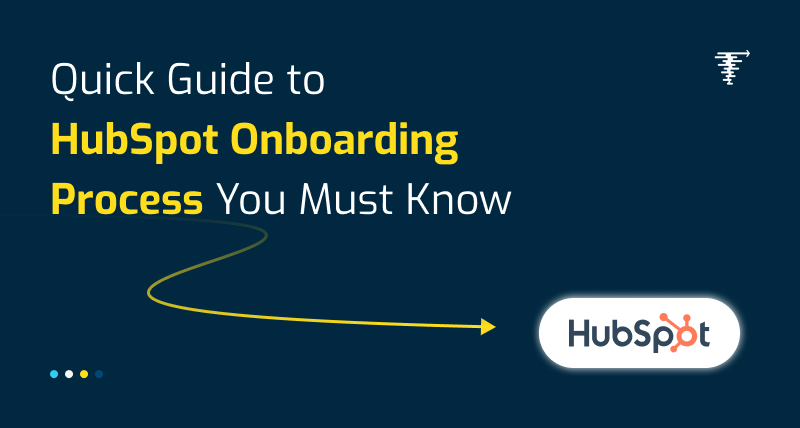

The journey of implementing HubSpot is not different from roaming in an unfamiliar city without a map: exciting but disorienting. Whether you are a first-time user of CRM platforms or switching from another software, the HubSpot onboarding process becomes your guide to effortlessly utilising the platform's full potential. So, where do you start?
In this post, we will talk about the actionable onboarding steps in two different ways to get started with HubSpot account setup without a hitch. From learning the most essential features to steering clear of common pitfalls, this guide helps you. Let's make your HubSpot onboarding journey smooth and effortless.
HubSpot onboarding process is a great way to get new customers. It involves identifying and defining customer needs, configuring HubSpot based on those needs, training team members on the customised system and monitoring teams and systems to ensure everything runs smoothly.
This quick HubSpot onboarding checklist helps you configure your CRM from scratch. Configuring your HubSpot portal includes all the assets you need like emails, workflows, lists and so on. Also, you can set up your marketing, sales and service-related features.
While many marketers and sales leaders require technical expertise to use HubSpot, there are still HubSpot-certified partners available to fill in any gaps. There is no one-size-fits-all strategy for HubSpot onboarding, but rather a tailored solution based on each client's needs.
Related Blog: 7 Reasons to Choose a Partner Agency for HubSpot Onboarding
In general, the entire HubSpot onboarding process can be broken down into two parts.
The HubSpot CRM onboarding strategy helps you identify your client needs and manage their onboarding process. In this planning stage, you will also need to define the HubSpot architecture needs, change management plans and inbound marketing strategy for your clients. This will ensure that everyone is on the same page and knows what needs to happen for your clients to be successful.
A lot of time for HubSpot implementation partners is spent focusing on the technical details for implementation. This includes everything from analytics, automation, custom objects, properties, to domain setup and integrations.
HubSpot onboarding services can help improve data hygiene and import multi-object custom databases for clients already using legacy systems. This is an optional step and relevant for clients using these kinds of systems. By working with HubSpot implementation partners, they can help clean up and improve the data so that it meets the standards of the new system.
HubSpot Training and development generally include creating SOPs, customising workflows and implementing HubSpot features. The team also provides one-on-one and group training sessions as needed during the HubSpot onboarding process.
No matter how great a process is, there's always room for improvement and optimisation. That's where the monitoring and evaluation frameworks by experts come in - they help to identify gaps so that ongoing support can be provided to fill those gaps.
The best HubSpot onboarding practices can pose some challenges in the client onboarding solutions if you're not using a professional team. Here are some common issues you might face and how to avoid them.

Data integration and migration are some of the more difficult aspects to tackle during the HubSpot onboarding process. A lot of people in businesses put high importance on data because it can be very helpful. However, managing data is a very technical task. To start, business users have to migrate their data from their old CRM platform to HubSpot. This requires taking into account factors such as data accuracy, object and field mapping and data placement validation.
Automation is a key asset for any business and the onboarding process on HubSpot is no different. The software offers a range of marketing automation tools to help with workflows, templates, pipelines and more. While automation can save you a lot of time and effort in the long run, setting it up in the first place can be quite painstaking.
Read Also: Why Your Business Needs HubSpot Onboarding?
Productive business management relies on comprehensive and valuable analytics and data tracking. But if you don't set up your metrics properly during the HubSpot onboarding, then you'll end up with inaccurate data. Ensure to properly configure your tracking settings to get the most accurate insights into your campaigns, websites and ads.
Swapping one platform for another can be a big change. To make things more difficult, the actual migration process is often incredibly frustrating with HubSpot CMS migration. For example, you have to ensure your URL structures are maintained through redirection and domain forwarding and match up your metadata to create uniform pages. All of these things need to go smoothly during the HubSpot data migration process.
The HubSpot onboarding process is designed to get you up and running with the tool as quickly as possible. Additionally, it ensures all assets you need are at your disposal. HubSpot has a lot of potential as it can be used as a customer relationship management (CRM) tool and a content optimisation system (COS). The tool can help enforce a content strategy that is effective and efficient. By amalgamating the marketing automation of HubSpot and the content curation strategy to achieve the business goals more efficiently and effectively.
But HubSpot is also a feature-heavy platform, making it the right choice for businesses with complex processes. Configuration can be tough, especially if you're new to the platform and managing integrations and pipeline scoring can be daunting tasks. However, partnering with certified partners can make it even more effortless.
Given the complexity of execution and implementation to your partner a HubSpot certified partner like TransFunnel is the best option. They integrate and implement the platform in a way that guarantees the ROI you are targeting to achieve. We enable and empower businesses by recommending the right MarTech roadmap in sync with inbound strategies, all this with end-to-end support and custom integration capabilities for streamlining your HubSpot onboarding process.
Get the HubSpot Onboarding Checklist for Successful Implementation now. Contact Us Now